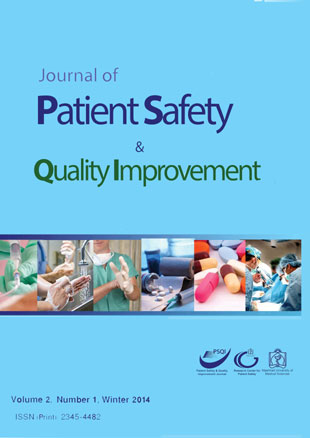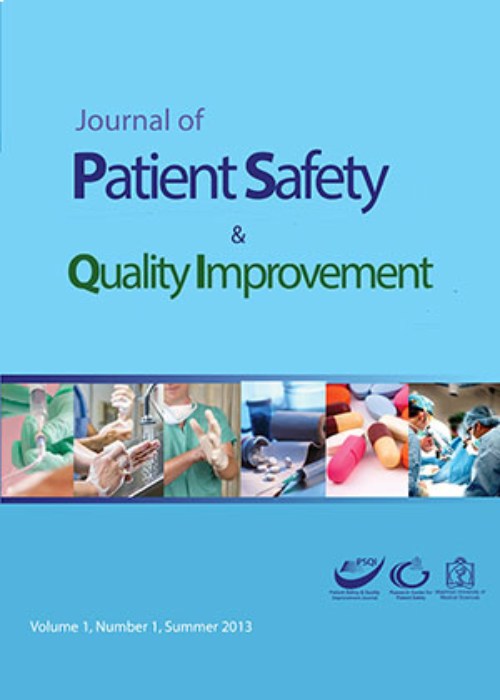فهرست مطالب

Journal Of Patient safety and quality improvement
Volume:2 Issue: 1, Winter 2014
- تاریخ انتشار: 1392/10/25
- تعداد عناوین: 8
-
Pages 36-43ObjectivesTo evaluate the effect of nicotinic acid in management of retinal vein occlusions (CRVO or BRVO).Materials And MethodsThis prospective nonrandomized pilot study included 20 patients (21 eyes) with CRVO or BRVO that received nicotinic acid (3 g/day) for 3 months. A complete ophthalmologic examination uncorrected visual acuity (UCVA), best spectacle-corrected visual acuity (BSCVA), testing for a relative afferent pupillary defect (RAPD), slit-lamp examination, gonioscopy, intraocular pressure (IOP) measurement, fundoscopy and fundus photography was performed.ResultsFour patients did not appear for follow-up and hypersensitivity reaction to nicotinic acid and severe hyperglycemia happened in two patients. Therefore, the results of treatment in 16 eyes of 15 are reported. These patients had a mean age of 59.56 ± 11.12 years. The average length of follow-up was 8.6 ± 2.7 months. The mean BSCVA was 1.56 ± 0.66 before treatment, 1.38 ± 0.72 (p >0.05) at one month and 0.88 ± 0.69 (p<0.01) at three months. The last BSCVA of all 16 eyes averaged 0.97 ± 0.73 (p<0.01). All patients had reduction of hemorrhagic events, cotton wool spots, edema in macula and disc, venous tortuosity, and dilation on basis of fundus photographs 3 months after treatment.ConclusionNicotinic acid usage provides enough time for development of collateral vessels, by induction of vasodilatation. Nicotinic acid use is tolerable and is related with mild systemic side effects.Keywords: BRVO, CRVO, Niacin, Nicotinic acid, Retinal Vein Occlusion
-
Pages 44-47ObjectivesFebrile seizures (FS) happen in 2-5% of children aged 6 months to 5 years. Several studies have confirmed that between 2 to 7% of children with FS, develop epilepsy later in life. This study was performed to evaluate the clinical aspects of patients with febrile seizure in our region.Materials And MethodsThis is a retrospective descriptive cross- sectional study that was performed in the pediatric ward of Ghaem hospital in Mashhad, Iran from Sep. 2004 to March 2005. 68 patients aged 6 months to 5 years were evaluated.ResultsMost patients were male and aged between 1 to 3 years. 25% had a past history of febrile seizures. Upper respiratory tract infections and gastroenteritis were among the most common causes of febrile seizures, respectively. Simple febrile seizures were seen in 64. 7% of the cases. Most of such patients had body temperature above 38. 5˚c at the time of seizure occurrence.ConclusionFebrile seizures were more frequently seen in boys aged 1 to 3 years. It most commonly occurred following an upper respiratory tract infection and due to rise in body temperature above 38. 5 ۫c.Keywords: Children, Convulsion, Fever, Infections
-
Pages 48-52ObjectivesClinical governance is a framework in which the organizations providing clinical services are responsible in exchange for the permanent improvement of quality and preserving the service’s high standard. It relies on the responsibility to maintain current levels of care and on clinical governance pillars to improve the quality of future care. Also, it is a concept that attempts to integrate the previous methods and tools in measuring and improving quality of care.Materials And MethodsThis descriptive-analytic-interventional study was conducted to evaluate the hospitals of Mashhad before and after the establishment of clinical governance in 2011. Data were collected by both questionnaires and observation.ResultsComparing the range of clinical governance’s pillars obtained, from the selected hospitals, showed a significant improvement in all studied axes following the establishment of clinical governance. The highest effectiveness was related to clinical audit, staff management and training axes, whereas the least effective part was the interaction with patients, their relatives and the community.ConclusionRegarding the significant difference in the obtained results after the establishment of clinical governance in this study, it could be concluded that the establishment of clinical governance and its performance could remarkably improve the quality of health services.Keywords: Clinical governance, Health services, Mashhad, Iran hospitals
-
Pages 53-57ObjectivesImproving the safety culture has been implemented as a key strategy to improve patient safety in health care systems. Several surveys have shown that assessment of patient safety attitude and examining to what extent these attitudes exist could be used as an effective tool for promoting patient safety and such data meet the managers’ information needs over time. Thus, considering the importance of patient safety as a basic principle in improving the quality of clinical services and patient satisfaction, this study was aimed to examine nurse’s attitudes towards the safety culture.Materials And MethodsIn this cross-sectional study the study population included nurses who were working in Marvdasht Shahid Motahary hospital, 2013. The sample size was selected by using a stratified randomization method as 114. The data were collected through HSOPSC questionnaire that has been introduced by the Health Care Research and Quality agency in 2004. The questionnaire is composed of eight parts. One part is about demographic and career information and other parts are about different dimensions of the patient safety culture. The collected data were then analyzed using the SPSS software and descriptive statistical tests.ResultsThe obtained results showed that the manager and supervisor expectations and actions in order to promote patient safety and the overall understanding of patient safety dimensions received the highest rating. On the other hand, staffing and non-punitive response to errors dimensions received the lowest score among the 12 dimensions of patient safety culture. Nonetheless, 44% of the studied population considered the patient safety status in their units as acceptable. However, 39% of the population had not reported any errors in the past 12 months.ConclusionBased on the results of the present study, the need to improve the safety culture at different dimensions seems necessary. Also, the culture of error reporting without any fear of censure or punishment should be institutionalized in future.Keywords: Attitude, Error, Patient safety, Safety culture
-
Pages 58-64ObjectivesProviding appropriate and quality care for delivery process can be done in the form of the «Labor Support». This approach is one of the key factors in reducing maternal and neonatal mortality rates and fulfilling the Millennium Development Goals. It has also an important role in the promoting maternal satisfaction. This study aims at assessing mothers’ view regarding the labor support quality.Materials And MethodsIn this cross-sectional study, 100 women who were hospitalized in the postpartum ward of Gonabad 22 Bahman Hospital, and had normal vaginal delivery were chosen using convenience sampling method. Participants were asked to fill in the demographic questionnaire and the form of assessment quality of labor support. Data analysis was performed by SPSS11. 5 software.ResultsIn this study, the data showed a mean participants’ age of 27/14 ± 5/89 years and a mean admission-delivery time interval of 305/13 ± 147/30 minutes. Results showed that 74 percent of women evaluated the emotional support as good, 93% of the women had reported that they are satisfied with physical support, and 92 percent of the participants had expressed that they were content with the instructions/information provided by the personnel.ConclusionAccording to this study, overall satisfaction from the quality of labor support has been acceptable in Gonabad 22 Bahman Hospital. Emotional supports stood lower when compared in terms of quality to two other categories.Keywords: Continuous labor support, Emotional support, Instruction, Information, Physical support, Quality
-
Pages 65-68IntroductionDelayed awakening from anesthesia remains one of the biggest challenges that involve anesthesiologists. Most commonly, delayed awakening is due to drugs effects persistence. Metabolic (like hypo- hyperglycemia), electrolyte, acid-base disorders and hypothermia may cause delayed emergence from anesthesia. Structural disorders of cerebral nervous system (like increase in intracranial pressure, brain ischemia) and psychological disorders can be regarded as other uncommon causes of this condition. Hypokalemia is induced by low potassium intake, excessive excretion from gastrointestinal (GI) and kidneys (like using diuretics) or a shift from extracellular space into intracellular space. Cases: In these two reported cases, although proper measures had been taken to reverse the effects of anesthetic drugs, the patients did not regain their consciousness as fast as expected. The only significant finding in postoperative tests, along with respiratory alkalosis, was low serum potassium level (K=2.5 and K=2.9 in the first and the second patients, respectively). Correction of serum potassium (to K=3.3 and K=3.2 in the first and the second, respectively) improved patients level of consciousness, and they were discharged from intensive care unit (ICU) with good general condition.ConclusionDuring surgery; pain, stress, sympathetic increase, catecholamine release and the consequent β-stimulation, certain drugs, and respiratory alkalosis due to hyperventilation may cause acute shift of potassium into the cells, which will be intensified in the patients with preoperative hypokalemia. Hypokalemia induces consciousness impairment and increases muscle relaxation, both of which affect patient awakening. Serum potassium evaluation is recommended in cases of delayed emergence from anesthesia.Keywords: Alkalosis, Delayed emergence, General anesthesia, Hypokalemia, Impaired consciousness
-
Pages 69-72IntroductionKeratoglobus is a controversial issue and still remains as one of the ambiguous corneal disorders; it can be managed by different surgical techniques successfully; yet the risk of globe rupture is high in these patients due to corneal weakness. In cases of progressive involvement, a large corneal graft is needed due to extreme thinness of the cornea. Recent adventures in surgical techniques have led to the introduction of new managements particularly in Keratoglobus treatment such as the «tuck procedure» in which a 12 mm corneo-scleral graft is miniaturized at its peripheral margin. A pocket is formed at the limbus of the recipient and the donor graft is «tucked» into it. We present a case of epikeratoplasty in Keratoglobus management. Case: A 45-year-old man with no history of a systemic disease underwent epikeratoplasty with the diagnosis of advanced bilateral keratoglobus since three years and six months before in the left and right eye, respectively. Pachymetry and best-corrected visual acuity (BCVA) were recorded before and six months after surgery. The highest recorded BCVA was 5/200 before the operation, whereas it was measured 6/10 (left eye) and 4/10 (right eye) at six-month follow-up examinations. Pachymetric findings improved from 244 to 773 and 212 to 744 (thinnest points) in the left and right eyes, respectively.ConclusionEpikeratoplasty is a relatively safe, effective and reversible extraoccular procedure in the management of keratoglobus. It can also be performed to flatten the cornea and protect it against acute corneal hydrops and perforation.Keywords: Epikeratoplasty, Keratoglobus, Surgical technique


